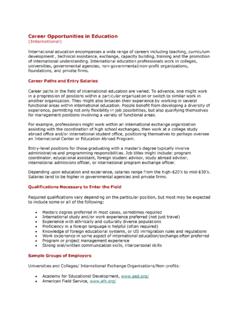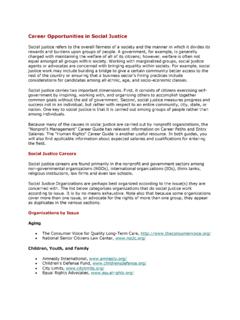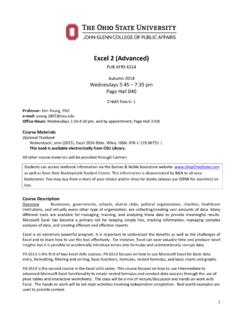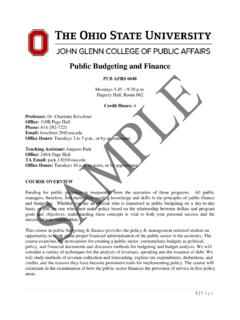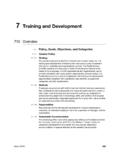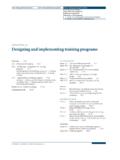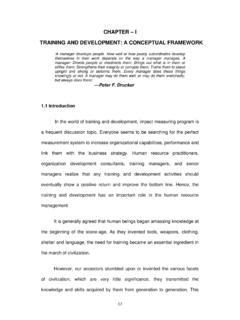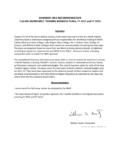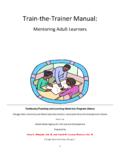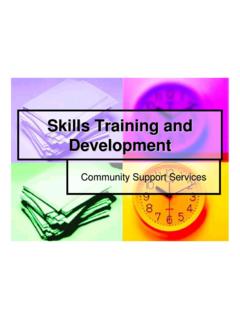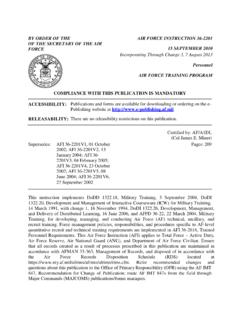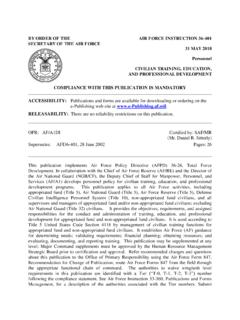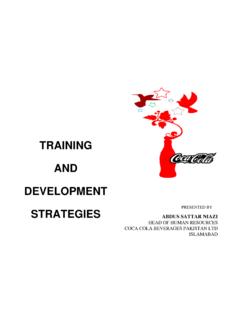Transcription of Career Opportunities in Human Resource Training …
1 Career Opportunities in Human Resource Training and development Attracting the most qualified employees and matching them to the jobs for which they are best suited is important for the success of any organization. However, many enterprises are too large to permit close contact between top management and employees. Human resources and Training managers and specialists provide this link. In the past, these workers have been associated with performing the administrative function of an organization, such as handling employee benefits questions or recruiting, interviewing, and hiring new personnel in accordance with policies and requirements that have been established in conjunction with top management. Today's Human resources workers juggle these tasks and, increasingly, consult top executives regarding strategic planning.
2 They have moved from behind-the-scenes staff work to leading the company in suggesting and changing policies. Senior management is recognizing the importance of the Human resources department to their bottom line (Occupational Outlook Handbook). In an effort to improve morale and productivity and limit job turnover, Human Resource specialists also help their firms effectively use employee skills, provide Training Opportunities to enhance those skills, and boost employee satisfaction with their jobs and working conditions. Although some jobs in the Human resources field require only limited contact with people outside the office, dealing with people is an essential part of the job. Typical positions in this field include: Human Resources Generalist In a small organization, a Human resources generalist may handle all aspects of Human resources work, requiring a broad range of knowledge.
3 The responsibilities of Human resources generalists can vary widely, depending on their employer's needs. In a large corporation, the top Human resources executive usually develops and coordinates personnel programs and policies. These policies are usually implemented by a director or manager of Human resources and, in some cases, a director of industrial relations. Director of Human Resources The director of Human resources may oversee several departments, each headed by an experienced manager, who most likely specializes in one personnel activity such as employment, compensation, benefits, Training and development , or employee relations. Training and development Managers Training and development managers and specialists conduct and supervise Training and development programs for employees.
4 Increasingly, management recognizes that Training offers a way of developing skills, enhancing productivity and quality of work, and building loyalty to the firm. Training is widely accepted as a method of improving employee morale, but this is only one of the reasons for its growing importance. Other factors include the complexity of the work environment, the rapid pace of organizational and technological change, and the growing number of jobs in fields that constantly generate new knowledge. In addition, advances in learning theory have provided insights into how adults learn, and how Training can be organized most effectively for them. Training Specialists Training specialists plan, organize, and direct a wide range of Training activities. Trainers conduct orientation sessions and arrange on-the-job Training for new employees.
5 They help rank-and-file workers maintain and improve their job skills, and possibly prepare development programs among employees in lower level positions. These programs are designed to develop potential and current executives to replace those retiring. Trainers also lead programs to assist employees with transitions due to mergers and acquisitions, as well as technological changes. In government-supported Training programs, Training specialists function as case managers. They first assess the Training needs of clients, and then guide them through the most appropriate Training method. After Training , clients either may be referred to employer relations representatives or receive job placement assistance. Planning and program development is an important part of the Training specialist's job.
6 In order to identify and assess Training needs within the firm, trainers may confer with managers and supervisors or conduct surveys. They also periodically evaluate Training effectiveness. Depending on the size, goals, and nature of the organization, trainers may differ considerably in their responsibilities and in the methods they use. Training methods include on-the-job Training ; schools in which shop conditions are duplicated for trainees prior to putting them on the shop floor; apprenticeship Training ; classroom Training ; and electronic learning, which may involve interactive Internet-based Training , multimedia programs, distance learning, satellite Training , videos and other computer-aided instructional technologies, simulators, conferences, and workshops for jobs requiring greater skill.
7 They help supervisors improve their interpersonal skills in order to deal effectively with employees. They may set up individualized Training plans to strengthen an employee's existing skills or teach new ones. Career Paths and Entry Salaries The duties given to entry-level workers will vary depending on whether they have a degree in Human Resource management, have completed an internship, or have some other type of Human resources-related experience. Entry-level workers often enter formal or on-the-job Training programs in which they learn how to classify jobs, interview applicants, or administer employee benefits. They then are assigned to specific areas in the personnel department to gain experience. Later, they may advance to a managerial position, overseeing a major element of the personnel program-compensation or Training , for example.
8 Compensation varies widely in HR jobs depending on the individual's skills, the size of the employer, and the industry involved. However, according to , the following median salary ranges are typical: HR generalist: $37,000 70,000. HR manager: $52,000 92,000. Benefits administrator: $35,000 70,000. Benefits analyst: $35,000 90,000. Compensation analyst: $40,000 100,000. EEO specialist (affirmative action coordinators): $45,000 90,000. Labor relations manager: $62,000 120,000. Training manager: $52,000 100,000. Recruiter: $40,000 90,000. VP of Human resources: $90,000 230,000. Qualifications Necessary/Application Procedures to Enter Field The Human resources field demands a range of personal qualities and skills. Human resources and Training managers and specialists must speak and write effectively.
9 The diversity of the workforce requires that they work with or supervise people with various cultural backgrounds, levels of education, and experience. They must be able to cope with conflicting points of view, function under pressure, and demonstrate discretion, integrity, fair-mindedness, and a persuasive, congenial personality. Because of the diversity of duties and level of responsibility, the educational backgrounds of Human resources and Training managers and specialists vary considerably. In filling entry- level jobs, employers usually seek college graduates. A master's degree in Human resources, labor relations, or in business administration with a concentration in Human resources management is highly recommended for those seeking general and top management positions.
10 Many colleges and universities have programs leading to a degree in personnel, Human resources, or labor relations. Some offer degree programs in personnel administration or Human resources management, Training and development , or compensation and benefits. Depending on the school, courses leading to a Career in Human resources management may be found in departments of business administration, education, instructional technology, organizational development , Human services, communication, public administration, or within a separate Human resources institution or department. Most prospective Human resources specialists should take courses in compensation, recruitment, Training and development , and performance appraisal, as well as courses in principles of management, organizational structure, and industrial psychology.
